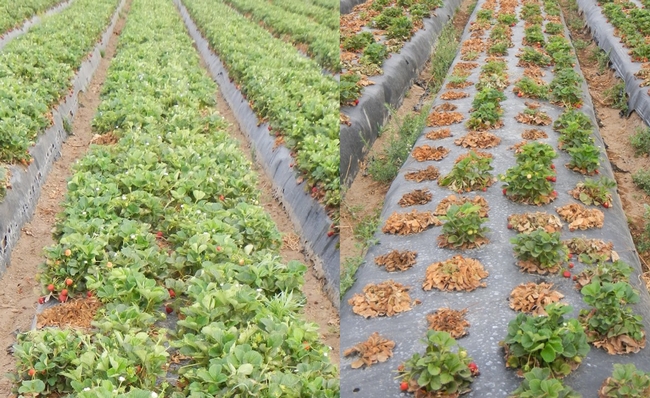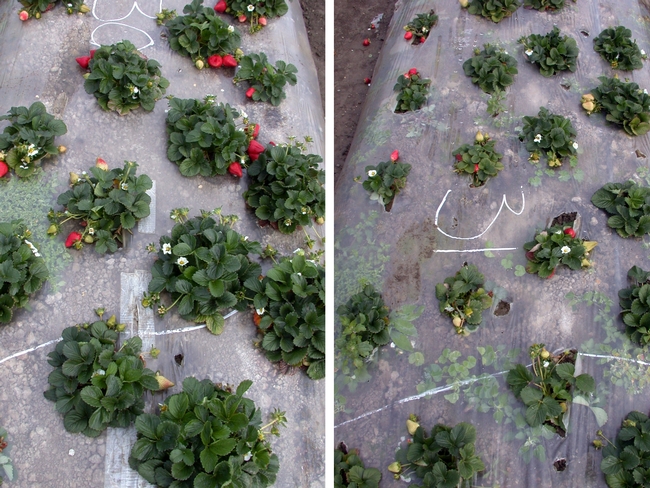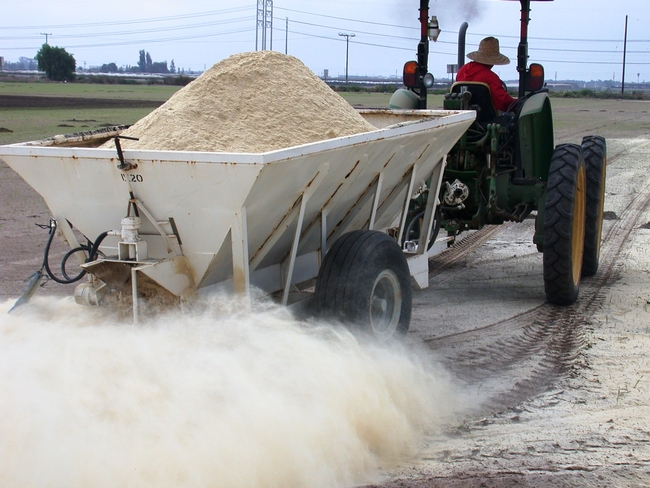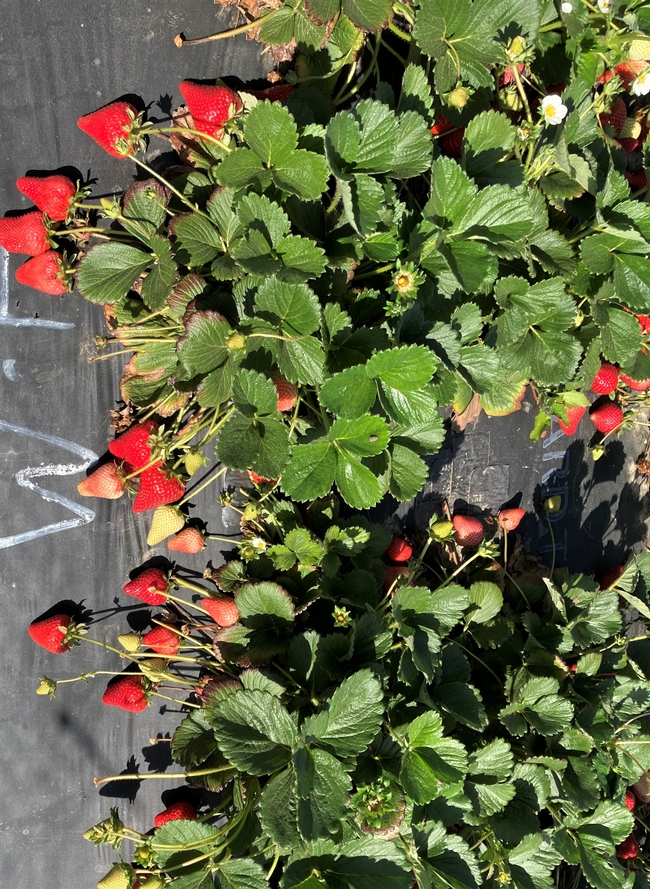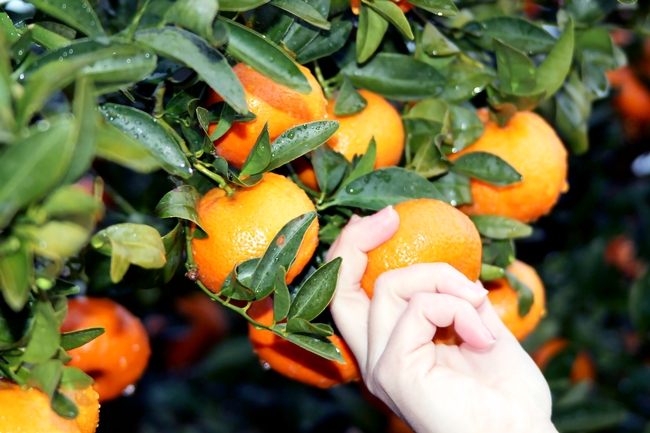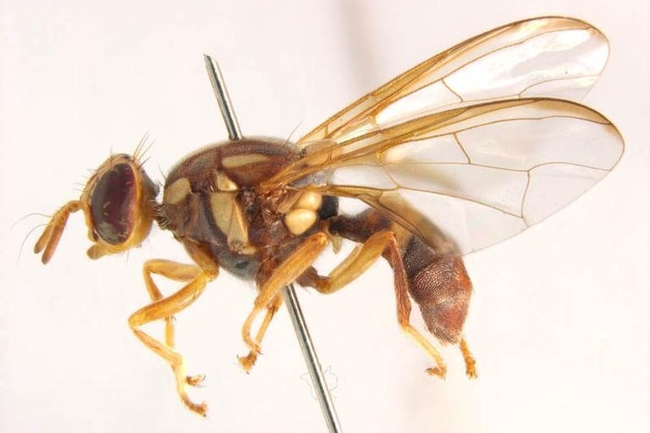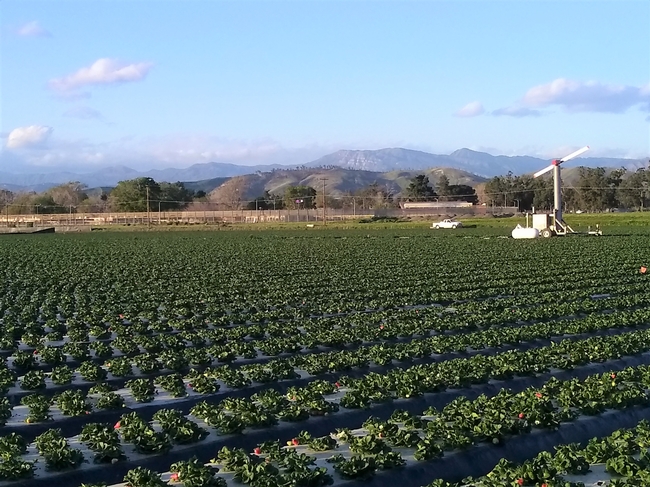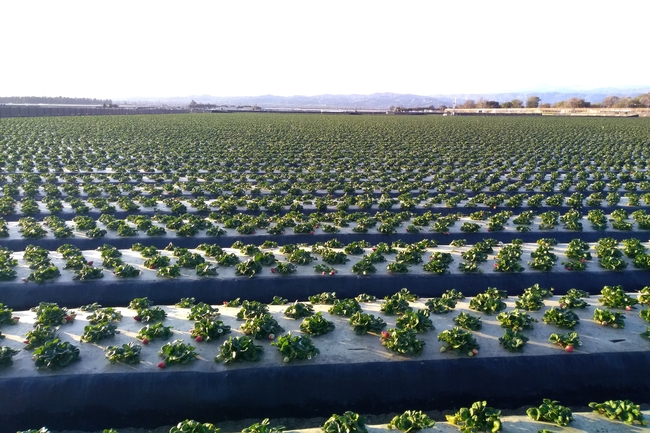Posts Tagged: Ventura
Organic strawberry yields boosted by technique refined through UCCE research
Anaerobic soil disinfestation helps suppress weeds, disease without fumigants
Troubled by puny plants, low yields and persistent mite problems, third-generation Southern California strawberry grower Glen Hasegawa was ready to give up on his transition from conventional to organic 12 years ago.
“I've always liked a challenge – but it turned out to be more of a challenge than I thought it would be!” he said.
But then, with the help of scientists including Oleg Daugovish, UC Cooperative Extension strawberry and vegetable crop advisor in Ventura County, Hasegawa tried a technique called anaerobic soil disinfestation (ASD). When applied correctly, the multi-step ASD process creates a soil environment that suppresses pathogens and weeds and makes for healthier, more robust crop growth.
“Back in the day, it was really hard to get the plant growing vigorously in organic,” said Hasegawa, owner of Faria Farms in Oxnard. “So we started using the ASD and then you could definitely see that the plant had more vigor and you could grow a bigger, better plant using it.”
Seeing that he could produce yields “in the neighborhood” of those grown in conventional strawberry fields fumigated with synthetic fumigants, Hasegawa was able to expand his original 10 acres of organic strawberries to 50 acres.
“I guess you could say I'm kind of a convert,” he said, noting that he now applies ASD to all his acreage each year in late spring.
Joji Muramoto, UC Cooperative Extension specialist in organic production based at UC Santa Cruz, has been experimenting with ASD since it was first brought to the U.S. from the Netherlands and Japan in the early 2000s. Carol Shennan, a professor in the Department of Environmental Studies at UCSC, and Muramoto were among the first to try the technique in California. They found that ASD successfully controlled an outbreak of Verticillium wilt – caused by the pathogen Verticillium dahliae – at UCSC's small organic farm in 2002.
Since then, Shennan, Muramoto, Daugovish and their colleagues have seen encouraging results at 10 trial sites across the state.
“We demonstrated that ASD can provide comparable yields with fumigants, in side-by-side replicated trials,” Muramoto said.
ASD promotes host of beneficial changes to soil ecosystem
ASD comprises three basic steps: incorporating a carbon source that is easily digestible by microbes in the soil (traditionally, rice bran has been used), further encouraging fermentation by covering the soil with plastic to limit oxygen supply, and finally adding water through drip irrigation to initiate the “anaerobic” decomposition of the carbon source and maintain the three-week “cooking” process.
The resulting cascade of chemical, microbiological and physical changes to the soil creates an ecosystem that is both conducive to strawberry growth – and inhospitable to pathogens and weeds.
“It's not like a pesticide where you have a mode of action, and thus resulting in ‘A' and ‘B' for you,” Daugovish explained. “There's a sort of cocktail of events that happens in the soil; they all happen interconnectedly.”
Compared to similar fields that did not undergo the process, ASD-applied organic strawberry fields across California have seen yields increase by 60% to 70% – and even doubling in some cases, according to Daugovish.
The UCCE advisor also shared the story of a longtime grower in Ventura County, who came to him with fields in “miserable” condition; they were plagued by one of the world's worst weeds, yellow nutsedge, and infected with charcoal rot, a disease caused by the fungus Macrophomina phaseolina. But after applying rice bran and following the ASD recipe, the grower saw phenomenal results.
“The only complaint he said to me was, ‘Now I have too many berries – we have to have more pickers to pick the berries!'” Daugovish recalled.
Via researchers' meetings, online resources, on-farm demonstration trials and word of mouth from peers, use of ASD by California strawberry growers has grown significantly during the past two decades. Tracking the purchase of rice bran, Muramoto estimated that about 2,500 acres were treated by the ASD-related practices in 2023 – covering roughly half of the 5,200 total acres of organic strawberries in California.
Muramoto directly links the growth of California organic strawberry production – which now comprises about 13% of total strawberry acreage in the state – with the increasing adoption of ASD.
“If you remove the acreage with the applied rice bran over the last 10 years or so, organic strawberry acreage is just flat,” he said.
Within the last decade, acreage of organic strawberries with ASD-related practices increased by 1,640 acres, which is a boon for air quality, human health and long-term soil vitality. According to Muramoto's calculations, that increase in organic acreage translates to a reduction of about 465,000 pounds of fumigant active ingredients that would have been used in growing conventional strawberries.
“There are hundreds of reports of acute illnesses related to fumigation in the record, so it's very important to find alternatives to fumigants,” said Muramoto, citing California Department of Pesticide Regulation documents.
Research continues to make ASD more economical, effective
The popularity of ASD has come at a price, however, for organic strawberry growers.
“There's more organic out there, and I think most of the organic guys are using it, so there's more demand on the rice bran; the price has been steadily going up every year, like everything else,” said Hasegawa, adding that he has been trying to decrease the amount of carbon while maintaining ASD's efficacy.
On top of greater demand from other growers and from beef cattle and dairy producers (who use rice bran as feed), the price also has increased due to higher costs in transporting the material across the state from the Sacramento Valley. So Daugovish and his colleagues – including Peter Henry, a U.S. Department of Agriculture plant pathologist – have been searching for a cheaper alternative.
“We all want an inexpensive, locally available, reliable, easy to use and functional carbon source, which sounds like a big wish list,” Daugovish said.
Carbon sources such as bark, wood chips, or compost are ineffective, as the crucial ASD microorganisms are choosy about their food.
“Microbes are just like cows; you can't feed them straight wood; they get pretty angry,” Daugovish explained. “And if you feed them something with too much nitrogen, they can't digest it – they get the runs. Microbes are the same way – you have to have the right proportion of stuff so they feel comfortable doing what they're doing.”
In search of an ideal replacement, researchers tried and ruled out grass clippings, onion waste, glycerin and coffee grounds. Finally, they pivoted to a material with properties very similar to rice bran: wheat bran, in the form of wheat middlings (also called midds, a byproduct of flour milling) and dried distillers' grain (DDG, a byproduct of ethanol extraction).
After field experiments in Santa Paula, the UC and USDA researchers found that midds and DDG were just as effective at controlling soilborne pathogens and weeds as rice brain – but at 25% to 30% less cost. Their results were published last year in the journal Agronomy.
“Not surprisingly, the wheat bran has worked almost exactly the same as rice bran,” Daugovish said.
He and Muramoto are now conducting trials with wheat bran at commercial fields, and the initial results are promising. Daugovish said the grower at one site in Ventura County has seen a 90% reduction in Macrophomina phaseolina, the causal pathogen of charcoal rot, in the soil – and an 80% to 90% drop in yellow nutsedge germination. They are waiting for final yield numbers after the coming summer.
While ASD has been beneficial to organic productivity and soil health, both Daugovish and Muramoto acknowledged specific limitations in suppressing the “big three” strawberry diseases: Verticillium wilt, Fusarium wilt and charcoal rot. In coastal areas with cooler soil temperatures, for example, ASD can actually exacerbate the latter two diseases, as the fungal pathogens feed on the rice bran.
“We know it works at warmer temperatures, but, practically, it's hard to do in coastal California,” Muramoto said. “It would be nice if we can find a way to suppress Fusarium wilt at a lower temperature, but we don't have it right now.”
That's why researchers emphasize that ASD is not a “silver bullet.” It's just one tool in the organic toolbox, which includes careful crop rotation, disease-resistant strawberry varieties and better diagnostic tests that help growers pinpoint outbreaks and make the application of various methods more targeted and more efficient.
And scientists will continue to optimize ASD to make it more effective and economical for growers in the different strawberry regions of California – from the Central Coast to the Oxnard Plain.
“We know it can work really well; it's just finding the most sustainable way to do this in our region,” Daugovish said. “We've got to just have an open mind and keep trying.”
First-ever Queensland fruit fly quarantine restricts moving homegrown produce
QFF quarantine in LA, Ventura counties among seven fruit fly quarantines statewide
Residents in multiple Southern California and Northern California counties should not move homegrown fruits and vegetables from their properties to help contain several species of fruit fly that can destroy crops and impact the livelihoods of local farmers.
With sharing and gifting of food integral to the holiday season, the California Department of Food and Agriculture is reminding people to heed the seven active fruit fly quarantines aimed at controlling the Mediterranean fruit fly, Oriental fruit fly, Tau fly and Queensland fruit fly. The links below describe quarantine zone boundaries:
- Mediterranean fruit fly: Los Angeles County, Leimert Park Area
- Oriental fruit fly: San Bernardino and Riverside Counties, Redlands and Yucaipa Areas
- Oriental fruit fly: Sacramento County, Rancho Cordova Area
- Oriental fruit fly: Contra Costa County, Brentwood Area
- Oriental fruit fly: Santa Clara County, Santa Clara Area
- Tau fly: Los Angeles County – Stevenson Ranch, Valencia, Santa Clarita Areas
- Queensland fruit fly: Ventura and Los Angeles Counties, Thousand Oaks Area
People within these zones should consume or process (i.e., juice, freeze or cook) their homegrown fruits and vegetables at the place of origin and not move them off their property. Uneaten produce should be double-bagged in plastic bags and disposed of in the landfill bin – not compost or green waste.
Queensland fruit fly threatens California citrus, other crops
The Queensland fruit fly (Bactrocera tryoni) quarantine is the first of its kind in the U.S. Although QFF was first seen in California in 1985, the recent detection of two adult males triggered the unprecedented quarantine action by USDA's Animal and Plant Health Inspection Service and CDFA.
“This pest has earned a bad reputation for wreaking havoc on fruit production in Australia, where it is native,” said Hamutahl Cohen, University of California Cooperative Extension entomology advisor for Ventura County. “Adult flies lay their eggs in fruit, and the eggs hatch into larvae that then feed on the fruit, causing damage.”
And while females of other fruit fly species live for only two or three months, QFF females are unique in that they can live up to a year, according to Cohen.
“Once QFF populations take root, they're challenging to manage because females can each lay up to 100 eggs per day,” Cohen said.
In addition to being highly adaptable to a variety of environmental conditions, QFF has more than 170 host plants – including a wide range of California commodities such as citrus, grape, strawberry, fig, avocado, apricot, peach, cherry, nectarine, plum, pear, apple, tomato and sweet pepper.
The threat to citrus is especially concerning, as Southern California growers continue to grapple with the specter of spreading huanglongbing (HLB) disease, which kills citrus trees. Cohen said residents of citrus-growing regions can do their part to help their neighbors and local economy by respecting quarantine restrictions.
“Growers are already dealing with other invasive species like Asian citrus psyllid [vector of HLB pathogen], so we as homeowners need to prevent the spread of fruit flies to reduce the burden on them,” she explained.
While a spike this year in the detections of multiple fruit fly species was likely caused by a host of factors, Cohen speculates that increased post-pandemic travel is helping to move the flies. And with holiday travel in full swing, she said it's important to practice “Don't Pack a Pest” principles.
“Invasive species often hitchhike on fruits and vegetables brought into California by travelers – that's why we often first find invasive species in urban and suburban backyards, and not on farms,” Cohen said. “Travelers entering the U.S. can visit dontpackapest.com to learn about which products they can and cannot bring back with them.”
To report a suspected infestation of fruit fly larvae in homegrown produce, call the CDFA pest hotline at 1-800-491-1899. Growers with questions and concerns are urged to contact their local agricultural commissioner's office.
Climate-Change Resources
University of California UC ANR Green Blog (Climate Change and Other Topics) https://ucanr.edu/blogs/Green/index.cfm?tagname=climate%20change (full index)
Examples:
- Save Trees First: Tips to Keep Them Alive Under Drought https://ucanr.edu/b/~CdD
- Landscaping with Fire Exposure in Mind: https://ucanr.edu/b/~G4D
- Cities in California Inland Areas Must Make Street Tree Changes to adapt to Future Climate https://ucanr.edu/b/~oF7
Drought, Climate Change and California Water Management Ted Grantham, UC Cooperative Extension specialist (23 minutes) https://youtu.be/dlimj75Wn9Q
Climate Variability and Change: Trends and Impacts on CA Agriculture Tapan Pathak, UC Cooperative Extension specialist (24 minutes) https://youtu.be/bIHI0yqqQJc
California Institute for Water Resources (links to blogs, talks, podcasts, water experts, etc.) https://ciwr.ucanr.edu/California_Drought_Expertise/
UC ANR Wildfire Resources (publications, videos, etc.) https://ucanr.edu/News/For_the_media/Press_kits/Wildfire/ (main website)
-UC ANR Fire Resources and Information https://ucanr.edu/sites/fire/ (main website)
-Preparing Home Landscaping https://ucanr.edu/sites/fire/Prepare/Landscaping/
UC ANR Free Publications https://anrcatalog.ucanr.edu/ (main website)
- Benefits of Plants to Humans and Urban Ecosystems: https://anrcatalog.ucanr.edu/pdf/8726.pdf
-Keeping Plants Alive Under Drought and Water Restrictions (English version) https://anrcatalog.ucanr.edu/pdf/8553.pdf
(Spanish version) https://anrcatalog.ucanr.edu/pdf/8628.pdf
- Use of Graywater in Urban Landscapes https://anrcatalog.ucanr.edu/pdf/8536.pdf
- Sustainable Landscaping in California https://anrcatalog.ucanr.edu/pdf/8504.pdf
Other (Non-UC) Climate Change Resources
Urban Forests and Climate Change. Urban forests play an important role in climate change mitigation and adaptation. Active stewardship of a community's forestry assets can strengthen local resilience to climate change while creating more sustainable and desirable places to live. https://www.fs.usda.gov/ccrc/topics/urban-forests
Examining the Viability of Planting Trees to Mitigate Climate Change (plausible at the forest level) https://climate.nasa.gov/news/2927/examining-the-viability-of-planting-trees-to-help-mitigate-climate-change/
Reports and other information resources coordinated under the auspices of the United Nations and produced through the collaboration of thousands of international scientists to provide a clear and up to date view of the current state of scientific knowledge relevant to climate change. United Nations Climate Action
Scientific reports, programs, action movements and events related to climate change. National Center for Atmospheric Research (National Science Foundation)
Find useful reports, program information and other documents resulting from federally funded research and development into the behavior of the atmosphere and related physical, biological and social systems. Search and find climate data from prehistory through to an hour ago in the world's largest climate data archive. (Formerly the "Climatic Data Center") National Centers for Environmental Information (NOAA)
Think tank providing information, analysis, policy and solution development for addressing climate change and energy issues (formerly known as the: "Pew Center on Global Climate Change"). Center for Climate & Energy Solutions (C2ES)
Mapping Resilience: A Blueprint for Thriving in the Face of Climate Disaster. The Climate Adaptation Knowledge Exchange (CAKE) was launched in July 2010 and is managed by EcoAdapt, a non-profit with a singular mission: to create a robust future in the face of climate change by bringing together diverse players to reshape planning and management in response to rapid climate change. https://www.cakex.org/documents/mapping-resilience-blueprint-thriving-face-climate-disaster
Cal-Adapt provides a way to explore peer-reviewed data that portrays how climate change might affect California at the state and local level. We make this data available through downloads, visualizations, and the Cal-Adapt API for your research, outreach, and adaptation planning needs. Cal-Adapt is a collaboration between state agency funding programs, university and private sector researchers https://cal-adapt.org/
Find reports, maps, data and other resources produced through a confederation of the research arms of 13 Federal departments and agencies that carry out research and develop and maintain capabilities that support the Nation's response to global change. Global Change (U.S. Global Change Research Program)
The Pacific Institute is a global water think tank that combines science-based thought leadership with active outreach to influence local, national, and international efforts to develop sustainable water policies. https://pacinst.org/our-approach/
Making equity real in climate adaptation and community resilience policies and programs: a guidebook. https://greenlining.org/publications/2019/making-equity-real-in-climate-adaption-and-community-resilience-policies-and-programs-a-guidebook/
Quarterly CA Climate Updates and CA Drought Monitor Maps (updated each Thursday) https://www.drought.gov/documents/quarterly-climate-impacts-and-outlook-western-region-june-2022
Drought focus of Water Resources IMPACT magazine special issue
UC ANR experts address emotional toll of drought
Preparing the American West for prolonged drought is the focus of a double issue of Water Resources IMPACT magazine. The California Water Commission staff are guest editors for this special open-access edition of the magazine, which is published by the American Water Resources Association.
Faith Kearns, academic coordinator of University of California Agriculture and Natural Resources' California Institute for Water Resources, is among the authors delving into how drought impacts people and the environment and how we can better prepare for the inevitable.
The first issue, published on Feb. 14, focuses on water scarcity issues confronting California and the ways these issues affect different sectors.
In “Trauma, Care, and Solidarity: Addressing the Emotional Toll of Chronic Drought,” Kearns highlights the effects of drought on mental health. She points to the spike in suicide hotline calls when wells ran dry in Southeast Asian communities in California's Central Valley.
By listening to Southeast Asian farmers, Ruth Dahlquist-Willard and Michael Yang of UC Cooperative Extension were able to “lighten the load” for them by providing pragmatic support, Kearns writes.
“The scale of some of these highly emotional issues – drought, wildfires, climate change – can make them seem incredibly difficult, if not impossible, to deal with,” Kearns said. “At the same time, they are affecting everyone living in the western U.S. on a daily basis. I wanted to highlight and provide models based on work that people – whether they are researchers, clinical psychologists, or Cooperative Extension advisors – are doing right now to ease the way.”
The authors who contributed to the double issue are a diverse array of Tribal experts, academics, nongovernmental organization thought-leaders, water managers and water policy influencers, each of whom brings their own perspective on the topic of drought. Their expertise and perspectives in climate science, water policy and water management will help inform drought-related decision-making and support policies that better prepare the state to thrive during periods of prolonged water scarcity.
In addition to Kearns, the first issue includes articles contributed by:
- Samantha Stevenson, University of California, Santa Barbara
- Jay Lund, University of California, Davis
- Ron Goode, North Fork Mono Tribe
- Andy Fecko, Placer County Water Agency
- Jeff Mount, Public Policy Institute of California, and Ted Grantham, University of California, Berkeley/UC Cooperative Extension
- Nat Seavy and Karyn Stockdale, National Audubon Society
- Kjia Rivers, Community Water Center
- Cannon Michael, Bowles Farming
- Michelle Reimers, Turlock Irrigation District
The January/February edition of Water Resources IMPACT magazine can be accessed, free of charge, on the American Water Resources Association website at https://www.awra.org under “Publications.”
The second issue, to be published in March, will focus on drought response, considering the options for adaptation. This two-part series complements the Commission's work on strategies to protect communities and fish and wildlife in the event of a long-term drought.
Agricultural research and education center moving to new site in Ventura County
UC Hansen Research and Extension Center to expand capacity at Camarillo location
The University of California Hansen Agricultural Research and Extension Center – the site of popular school field trips, 4-H programs, a UC Master Gardener demonstration garden, and numerous research trials on crops and landscape plants – is moving to a new location on the west side of Camarillo. The center was established through an endowment bequeathed to the UC by Saticoy farmer Thelma Hansen, who sought to support university research and extension activities benefiting Ventura County.
For the past 25 years, Hansen REC has been located on the historic Faulkner Farm in Santa Paula. At 27 acres, Hansen REC was the smallest of the nine RECs across the state operated by UC Agriculture and Natural Resources; in 2019, UC ANR leadership decided a larger property was needed to expand the center's capacity. The Faulkner Farm was sold in March 2021, but a portion was leased back to the UC to sustain its programs until a new location was identified.
In December 2022, the UC acquired a 114-acre farm property in Camarillo to serve as Hansen REC's new home. Moving structures and equipment from Faulkner Farm will take place over the next six months. Public programs at the new location are on hold until seismic retrofitting and other building upgrades are completed. A new research and educational facility also will be built, with an estimated opening date in 2027 or 2028.
“Our planning committee looked for a site on the Oxnard Plain that is representative of the coastal agriculture environment and conducive to research on Ventura County's high-value crops, such as strawberries,” said Annemiek Schilder, Hansen REC director. “We also sought a location with diverse soil types, access to sufficient irrigation water, and a low risk of flooding – and we're pleased that this Camarillo property meets most of our search criteria.”
Of the approximately 104 cultivable acres, 28 are certified organic, which will allow researchers to study organic as well as conventional crop production methods, Schilder noted. She said another bonus of the new location is its proximity to California State University, Channel Islands and the Rodale Institute California Organic Center, which are both potential partners for future research and a student organic farm on site.
Initial plans for the new Hansen REC facility include offices, conference rooms, laboratories, greenhouses, a demonstration kitchen, and indoor and outdoor education areas. The center will aim to be water-efficient and energy-neutral, relying on solar panels for much of its energy usage. The UC Cooperative Extension Office in Ventura is also slated to move to the new facility.
“We fully expect Hansen REC to become a vibrant research and education hub that provides science-based solutions and is responsive to the needs of agricultural, rural and urban communities and the environment in Ventura County,” said Glenda Humiston, UC vice president for agriculture and natural resources. “We're excited to expand current programming while bringing in new educational opportunities, such as the UC Master Food Preserver and Master Beekeeper programs.”

